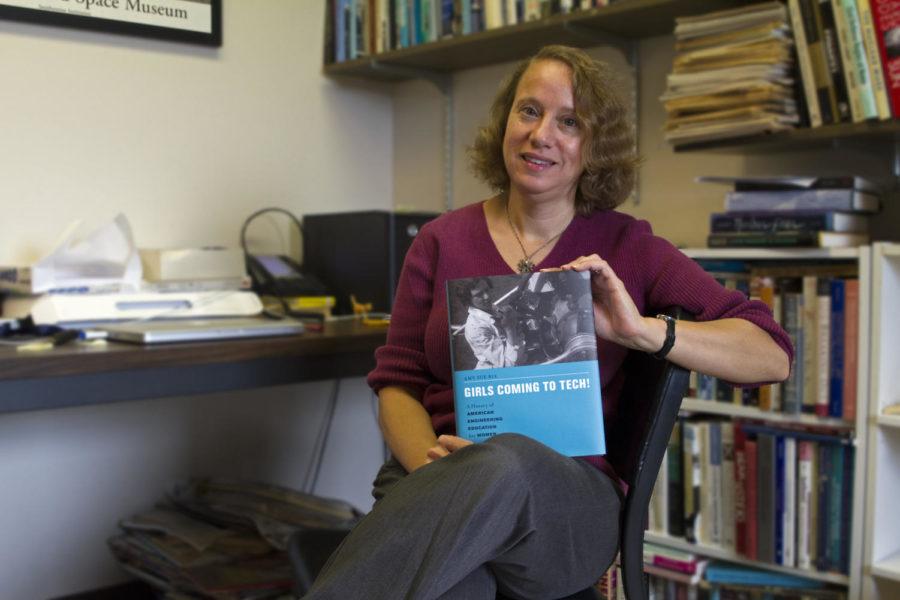History professor writes book about women in engineering, tech fields
Amy Bix, associate professor in history, wrote a book describing the hardships and benefits of being a woman in the engineering and technology field.
October 10, 2014
The representation of women in engineering programs has come a long way, but the journey to completely equal representation is far from over.
Amy Bix, an associate professor in history, published a book this year called “Girls Coming to Tech!: A History of American Engineering Education For Women.”
Bix’s book focuses on the history of women in engineering and the discrimination they have suffered from while entering the field.
Bix’s interest in the topic was piqued with a class she teaches titled the History of Women in Science, Medicine, and Technology. Bix found plenty of materials for her students to read about the history of women in science and medicine, but couldn’t find anything about the history of women in engineering.
“When it came to women in engineering, I literally couldn’t find anything for my students to read,” said Bix.
At first she decided to work around it, but then she decided she would have to write the book herself.
While writing her book, Bix found that the history of women in engineering differed from the history of women in science and medicine. Women in science were allowed access to the field through men in their families and women in medicine were always traditional healers.
Women weren’t allowed acceptance into medical school, but were allowed to be nurses. Only a handful of women in the late 1800s and early 1900s studied engineering, but after WWII began women were called to take the place of men who had gone off to war.
In her book, Bix focuses on three colleges: CalTech, MIT, and Georgia Tech. CalTech, a science and engineering college in California, only began to allow women access to the engineering program because the men in the college needed someone to date.
Iowa State has played a vital role for women in engineering. Two of the first female engineers graduated from Iowa State. One became a drafting professor here and another went on to be an assistant professor elsewhere.
In the 1950s, women made up less than one percent of American students in engineering, but this number has risen to 18.4 percent of bachelor’s degrees, 22.6 percent of master’s degrees, and 21.8 percent of doctorates as of 2010 and 2011, according to the MIT Press.
Bix attributed this success to community outreach efforts and programs for young girls.
“The thing that’s really changed, over the last few decades is the organization and institutionalization of support for women who want to go into engineering,” Bix said.
Bix stressed the importance of getting young girls excited about engineering. Girls should be taught that it’s “normal and cool” to know their way around technology. Bix said it’s too late once they reach college because they haven’t taken the proper courses in high school.
WiSE, or Women in Science and Engineering, is a program at Iowa State that does K-12 outreach, works on retaining students and provides plenty of resources for women in STEM majors on campus.
WiSE works with younger girls to encourage them to consider careers in science and engineering. On campus WiSE provides learning communities, peer mentoring, course clustering, and other community building recourses to fight off feelings of isolation that some women may have.
“We like to see the WiSE program as a foundation for women in STEM,” said Allie Rowe, undergraduate program coordinator for WiSE.
Although the numbers of women in engineering have risen, enrollment has plateaued and it’s a challenge to understand why.
“My own perspective as a historian is that a lot of it comes back to the history that engineering is so much more masculine than those fields were,” Bix said.
Rowe and Lora-Leigh Chrystal, the director of WiSE, said the reason for the plateau might be the way children are socialized. Messages from society push children into gender roles early on.
Bix said that getting the numbers of women in engineering fields up isn’t going to be “quick and easy”, but both the field of engineering and women as a whole will benefit from the diversity.
“The outreach piece is so crucial to this whole puzzle,” said Rowe.
Lydia Barrett, a junior in mechanical engineering, felt welcomed into the engineering program.
“The students are really great, you’re just one of them. You’re not really any different,” Barrett said.
Barrett says that there are plenty of resources for students in STEM majors on campus, but WiSE is the only one she knows of that is for women.
“People notice that you’re the girl, but they don’t make it a big thing,” said Barrett.

















